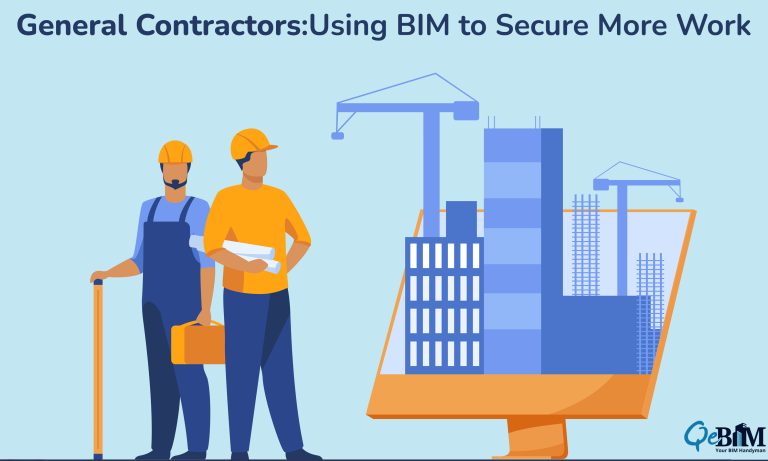General Contractors: Using BIM to Secure More Work

Introduction
For general contractors, keeping in front of their competitors is essential within the modern quickly changing construction business. Building information modeling (BIM) is one piece of technology that has fundamentally altered how construction projects are organized, designed, and carried out. General contractors may improve communication, expedite their business processes, and eventually land additional assignments by using BIM. The advantages of BIM for General Contractors are examined in this blog, along with how BIM modelling services can provide them an edge over their competitors.
Understanding BIM for General Contractors
Building information modelling (BIM) is a digital depiction of a building’s or infrastructure project’s structural and functional details. It incorporates 3D models, data, as well as details of numerous project elements, including structural, mechanical, electrical, plumbing, and architectural systems. All project stakeholders can collaborate on the framework provided by BIM to visualize, assess, and replicate the building process and operation when it is ever built.
1. Streamlining Construction Processes
Better Visualisation: BIM gives contractors the ability to view the project in 3D, which helps them better comprehend the intended use and see potential disputes or clashes while construction even starts. Early clash identification reduces rework, modification requests, and interruptions, which saves a lot of time and money.
Enhanced Coordination: By using BIM, general contractors may interact with architects, engineers, and other contractors more effectively. They may recognize and tackle coordination difficulties early by using a shared digital model, which results in more efficient construction workflows and enhanced project results.
Efficient Quantity Takeoffs: BIM models include comprehensive data for every project’s component, enabling precise quantity takeoffs as well as cost projections. This data might be used by general contractors to streamline material acquisition, cut waste, and enhance budgeting for projects and scheduling.
2. Enhancing Collaboration
All stakeholders must work together effectively for building projects to succeed. Among general contractors as well as other project participants, BIM offers a centralized interface that fosters collaboration and enhances communication:
Delivering Integrated Projects: By bringing together architects, engineers, contractors, and subcontractors on the same platform, BIM makes it easier to deliver assimilated projects. General contractors might offer their knowledge and insights by encouraging collaboration throughout the outset of a project, enabling building ability and analyzing to be considered throughout the design process.
Real-time collaboration is made possible by BIM Modeling Services for a variety of stakeholders. Project teams may access as well as edit the BIM model using cloud-based systems from any location, ensuring everybody is up to date. This more efficient teamwork minimizes misunderstandings, eliminates mistakes, and facilitates quicker decisions, thereby improving project effectiveness.
Conflict Resolution and Clash Detection: With the help of BIM, general contractors can find conflicts between various building systems or components. Contractors might prevent costly and laborious rework throughout construction or ensure a better project’s completion by covering these disputes earlier on.
3. Improving Project Visualization and Communication
Client Engagement: BIM offers clients an effective visual representation of the project that helps them comprehend the design concept and take wise decisions. In order to increase their chances of landing a job, general contractors may utilize BIM models to demonstrate their construction methodology, emphasize additional value characteristics, and inspire trust in clients.
Virtual Reality and Augmented Reality: BIM models may be utilized to create interactive visualizations as well as experiences using virtual reality (VR) and augmented reality (AR) technologies. Using these resources, general contractors may simulate building patterns, generate digital inspections, and proficiently explain complicated concepts to customers or project participants.
As-Built Documentation: During the course of a project, BIM models are an invaluable source of documentation. After a project is finished, effective asset oversight and upkeep might be facilitated by general contractors using BIM to collect or captivate in its entirety information.
4. BIM for Prefabrication and Modular Construction
BIM might be used by general contractors to streamline prefabrication and versatile building procedures. By accurately modeling prefabricated parts and modules, BIM enables contractors effectively organize and schedule their installation of them. General contractors may accelerate the manufacture and assembly of prefabricated pieces through the combination of BIM with computer-aided manufacturing (CAM) technology, speeding up construction and enhancing project quality.
5. BIM for Facility Management
BIM models are invaluable for facility oversight throughout the construction phase. A thorough BIM model including details regarding the building’s infrastructure, machinery, and maintenance requirements might be delivered to clients by general contractors. This makes it possible for facility managers to efficiently oversee and uphold the building over the course of its life, minimizing interruption and improving its efficiency.
6. BIM for Project Documentation and Handover
BIM models help to streamline the transfer of responsibility and act as useful project records. Construction timelines, supplies needed, and maintenance guides may all be incorporated by general contractors into the BIM model to produce an extensive digital record of the construction endeavor. This documentation is useful for project audits, afterward assessments, and upcoming upgrades or additions.
Conclusion
To acquire an unfair edge within the cutthroat construction market of today, general contractors must adopt the technology. General contractors can get many advantages from building information modeling (BIM), such as simplified construction procedures, better cooperation, better visualization, as well as effective communication. By completing projects with higher precision, efficacy, and cost-effectiveness, general contractors may enhance their probability of getting additional work by utilizing BIM modeling services.